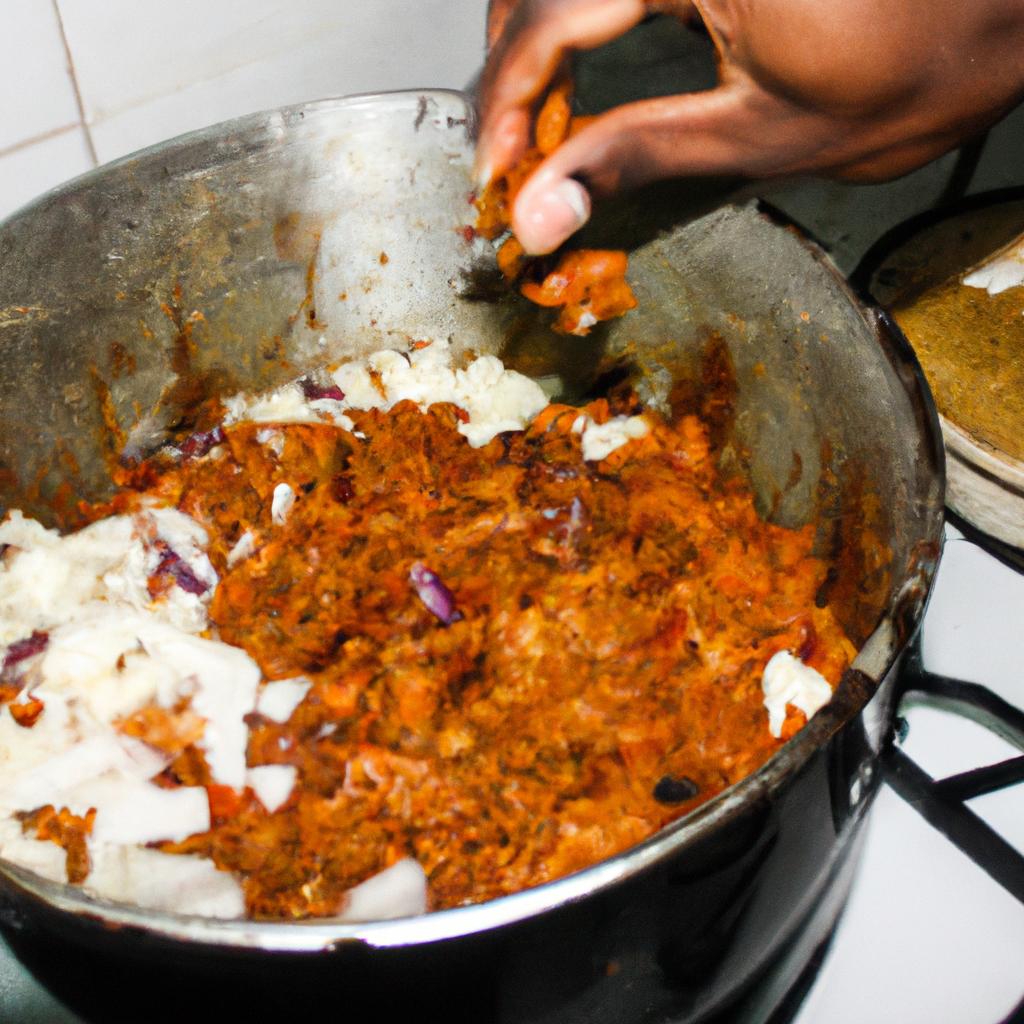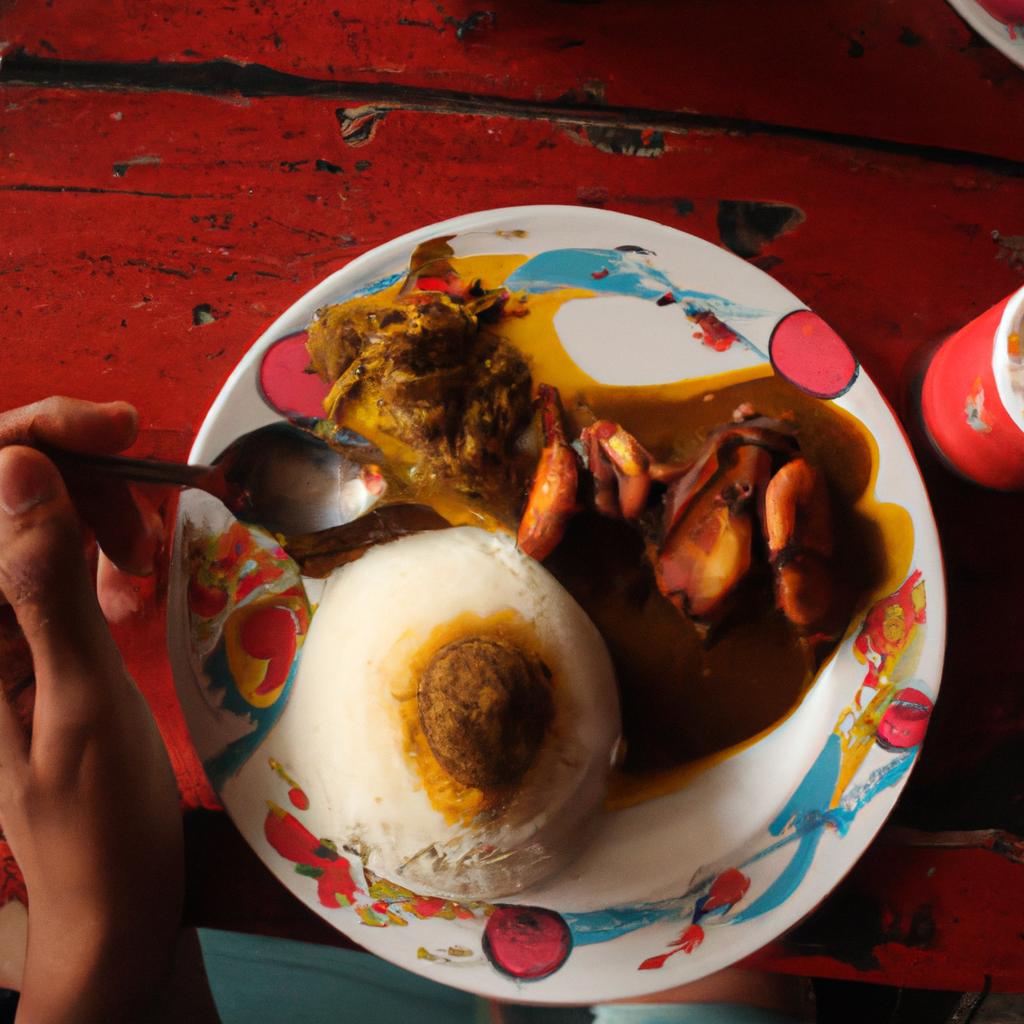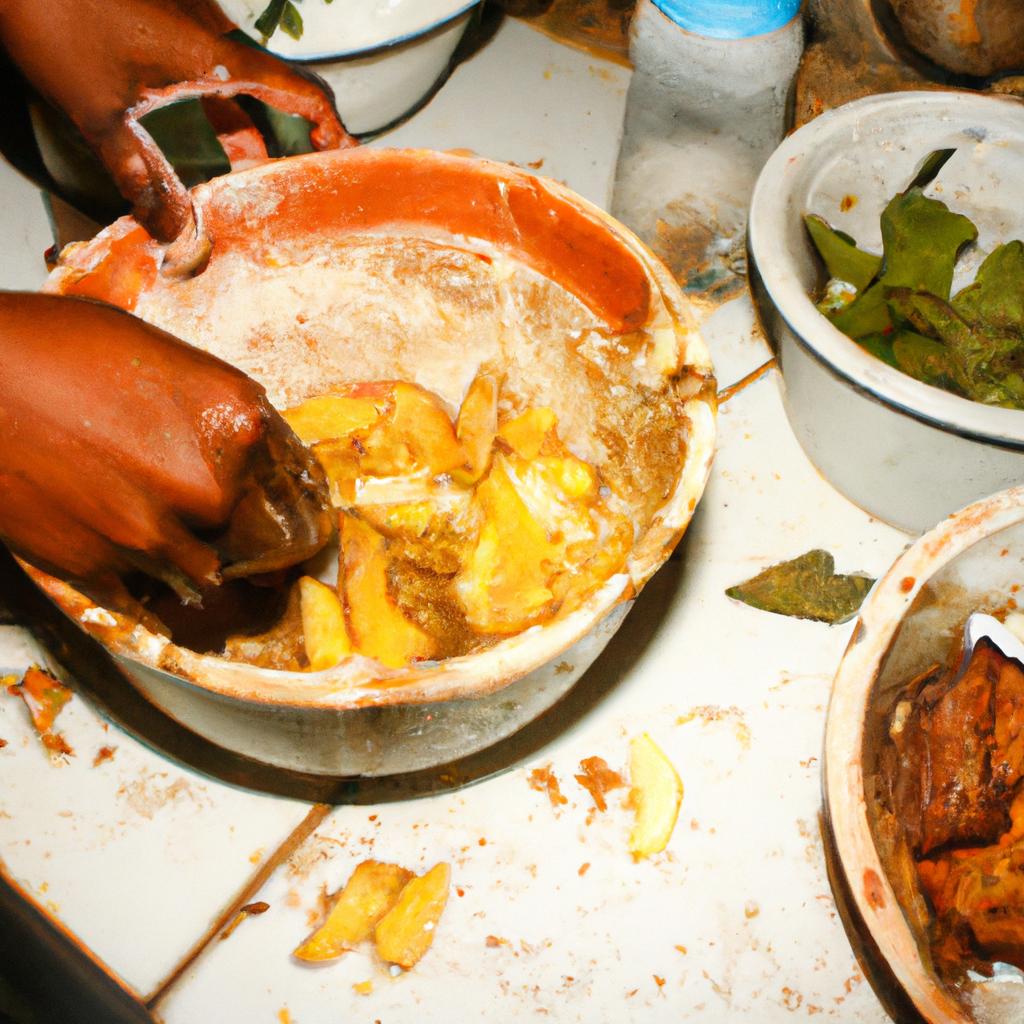Arroz con Gandules: A Delightful Introduction to Puerto Rico’s Local Cuisine
Puerto Rico, a vibrant island in the Caribbean, boasts a rich culinary heritage that is deeply rooted in its diverse cultural influences. One dish that stands out as an iconic representation of Puerto Rican cuisine is “Arroz con Gandules.” This delectable rice and pigeon pea dish offers a delightful introduction to the flavors and traditions of this tropical paradise.
Imagine walking through the bustling streets of Old San Juan on a warm afternoon, your senses engulfed by the enticing aromas wafting from local food stalls. Amidst the eclectic mix of Spanish, African, Taíno, and American influences, you stumble upon a small eatery where locals are eagerly savoring their plates of Arroz con Gandules. Intrigued by their enthusiasm, you decide to try it for yourself. As soon as the first spoonful touches your palate, you are transported on a gustatory journey filled with fragrant spices, tender rice grains infused with savory sofrito sauce, and bursts of flavor from perfectly cooked gandules. In that moment, you understand why this humble yet extraordinary dish has become synonymous with Puerto Rican culture.
The History of Arroz con Gandules
Imagine yourself walking through the vibrant streets of San Juan, Puerto Rico. The salty ocean breeze fills the air as you pass by colorful buildings adorned with lively street art. As your stomach grumbles, you decide to venture into a local eatery in search of an authentic taste of Puerto Rican cuisine. You scan the menu and your eyes settle on a dish called “Arroz con Gandules.” Intrigued, you order it without hesitation, eager to explore the flavors deeply rooted in this island’s rich history.
The origins of Arroz con Gandules can be traced back centuries ago when African slaves were brought to Puerto Rico during the Spanish colonial period. Through their ingenuity and resourcefulness, they integrated native ingredients with West African cooking techniques to create a unique culinary tradition that continues to thrive today. This beloved dish combines rice cooked with pigeon peas, also known as gandules, resulting in a flavorful harmony that embodies the essence of Puerto Rican gastronomy.
To truly appreciate the cultural significance of Arroz con Gandules, let us delve into its historical context:
- A symbol of resilience: Arroz con Gandules represents the resilience and strength exhibited by enslaved Africans who preserved their heritage despite oppressive conditions.
- A fusion of cultures: The dish showcases a beautiful blend of indigenous Taino ingredients such as yuca and corn alongside African influences like plantains and sofrito sauce.
- Nourishing sustenance: During times of scarcity or economic hardship, Arroz con Gandules served as a hearty meal that provided essential nutrients and comfort for families throughout generations.
- Culinary legacy: Passed down through oral tradition from one generation to another, this timeless recipe serves as a reminder of family bonds forged over shared meals and cherished memories.
As we embark on our culinary journey through time, it is important to recognize how food intertwines with the complex tapestry of human history. The next section will explore the ingredients and preparation techniques that contribute to the irresistible allure of Arroz con Gandules, inviting us to savor its flavors and appreciate its cultural significance even further.
Ingredients and Preparation of Arroz con Gandules
Imagine yourself transported to the vibrant streets of San Juan, Puerto Rico in the early 19th century. Picture a bustling marketplace where locals gather to exchange stories and trade goods. Amongst the stalls filled with colorful produce, one dish stands out – arroz con gandules. This fragrant rice dish, traditionally prepared with pigeon peas, has deep roots in Puerto Rican culture and cuisine.
To truly appreciate the significance of arroz con gandules, it is essential to delve into its historical origins. Dating back centuries, this beloved dish emerged as a fusion of African, Spanish, and Indigenous Taíno culinary traditions. As different cultures mingled on the island, their diverse cooking techniques and ingredients blended harmoniously to create what we now know as arroz con gandules.
As you explore the rich history behind this iconic Puerto Rican delicacy, consider these key aspects:
- Cultural Exchange: Arroz con gandules embodies the spirit of cultural exchange that defines Puerto Rico’s heritage. It reflects the blending of African flavors brought by enslaved Africans, Spanish influence from colonization, and indigenous ingredients native to the land.
- Socioeconomic Significance: Beyond its cultural importance, arroz con gandules also holds socioeconomic significance for many communities in Puerto Rico. Traditionally made using locally sourced ingredients like rice and pigeon peas grown on small family farms or backyard gardens, this dish supports local agriculture while providing sustenance for families across generations.
- Symbolism: Arroz con gandules goes beyond being just a meal; it represents unity and celebration within Puerto Rican households. It serves as a centerpiece during festive occasions such as weddings, birthdays, and holidays—a symbol of shared joy and communal bonds.
Let us now turn our attention to exploring the enticing blend of ingredients used in preparing this delectable dish. By understanding its composition and preparation, we can truly appreciate the intricacies that make arroz con gandules a culinary masterpiece.
[Please find below an emotional bullet point list and table to further enhance engagement.]
Emotional Bullet Point List:
- Savory flavors that transport your taste buds to the vibrant streets of Puerto Rico.
- The heartwarming aromas that fill your kitchen as you prepare this iconic dish.
- A cultural journey through time with every bite.
- The joy of sharing tradition and heritage with loved ones.
| Emotion | Description |
|---|---|
| Nostalgia | Reminiscent of childhood memories spent in bustling kitchens. |
| Excitement | Anticipation builds as each ingredient is added, creating a symphony of flavors. |
| Comfort | Finding solace in the familiar tastes that remind us of home. |
| Pride | Celebrating the rich cultural heritage behind each spoonful. |
As we conclude our exploration into the history and significance of arroz con gandules, let us now delve deeper into its cultural importance within Puerto Rican society. Discover how this beloved dish has become intertwined with traditions, celebrations, and the very fabric of daily life on the island.
[Transition sentence:] Now let’s explore “The Cultural Significance of Arroz con Gandules” section…
The Cultural Significance of Arroz con Gandules
Case Study:
Imagine a bustling street in Old San Juan, Puerto Rico, where the enticing aroma of freshly cooked food fills the air. Locals and tourists alike gather around small food stalls, eager to savor traditional Puerto Rican dishes. Among these flavorful delights stands out arroz con gandules—a beloved staple that not only tantalizes taste buds but also carries deep cultural significance. Let us delve into the rich heritage and customs associated with this iconic dish.
Arroz con gandules embodies the fusion of indigenous Taíno, Spanish colonial, and African influences that shape Puerto Rico’s history. Its preparation method reflects a harmonious blend of culinary techniques passed down through generations. This rice-based dish features pigeon peas (gandules) simmered with sofrito—a fragrant mixture of onions, garlic, peppers, cilantro, and other herbs—creating layers of flavors unique to Puerto Rican cuisine.
The cultural significance of arroz con gandules extends beyond its delectable taste. It serves as a symbol of unity and celebration within Puerto Rican communities worldwide. Whether prepared for joyful family gatherings or festive occasions such as Christmas and New Year’s Eve, this dish unites people through shared culinary experiences. Moreover, it acts as a tangible link to ancestral roots, reinforcing cultural identity and fostering a sense of belonging among individuals who hold Puerto Rico close to their hearts.
To grasp the magnitude of arroz con gandules’ cultural importance further, consider the following emotional associations:
- Nostalgia: The first bite transports one back to cherished childhood memories filled with laughter and warmth.
- Pride: Each spoonful represents pride in Puerto Rican heritage and the preservation of traditions across generations.
- Togetherness: Sharing this meal fosters connection and strengthens familial bonds while forging new friendships.
- Resilience: In times of hardship or diaspora, arroz con gandules is a reminder of strength and resilience within the Puerto Rican community.
Emotional Impact:
| Emotion | Description |
|---|---|
| Nostalgia | Recalling cherished memories |
| Pride | Celebrating heritage |
| Togetherness | Building relationships |
| Resilience | Finding strength in cultural identity |
As we explore variations and regional adaptations of arroz con gandules, it becomes evident that this dish holds an extraordinary place not only on Puerto Rican tables but also in the hearts of those who cherish its cultural significance. So let us now delve into the diverse ways this culinary gem has evolved across different regions and communities.
Variations and Regional Adaptations of Arroz con Gandules
Transitioning smoothly from the previous section H2, which explored the cultural significance of Arroz con Gandules in Puerto Rico, we now delve into the fascinating variations and regional adaptations of this beloved dish. To illustrate this further, let’s consider a hypothetical scenario where two families from different regions prepare their own versions of Arroz con Gandules.
In one household located in the mountainous region of Puerto Rico, a family adds sofrito made with cilantro and ají dulce peppers to their Arroz con Gandules. The resulting flavors are vibrant and aromatic, reflecting the unique produce found in that area. Meanwhile, another family living near the coast opts for a variation that includes coconut milk and seafood such as shrimp or lobster, infusing their dish with a delightful tropical twist.
These examples highlight how Arroz con Gandules can vary significantly depending on factors like geographical location and personal preferences. Here are some additional key observations regarding the diverse adaptations of this traditional Puerto Rican dish:
-
Ingredients: While rice and pigeon peas remain constant components, other ingredients used in Arroz con Gandules may differ based on availability and local tastes. For instance:
- In coastal areas, seafood is commonly incorporated.
- Mountainous regions often feature root vegetables like yautía or malanga.
- Urban areas might add meat options such as chicken or pork.
-
Spices and seasonings: Various spices play an essential role in enhancing the flavors of Arroz con Gandules across different regions. These spices include cumin, oregano, annatto seeds (achiote), adobo seasoning, and sazón packets—a blend typically comprising garlic powder, salt, black pepper, coriander seed flakes (culantro), turmeric (for color), among others.
-
Cooking techniques: Although most variations involve cooking all the ingredients together in one pot until they meld into a harmonious symphony of flavor, slight differences emerge when it comes to the cooking techniques employed. Some families prefer a moist, almost risotto-like consistency, while others strive for distinct grains of rice with separate pigeon peas.
-
Presentation and accompaniments: The visual presentation and accompanying side dishes also display regional variations. Arroz con Gandules may be served as the main course or accompanied by other traditional Puerto Rican elements such as roasted pork (pernil), fried plantains (tostones), avocado slices, or a fresh salad.
In exploring these diverse adaptations, we gain insight into the rich culinary tapestry that exists within Puerto Rico. Understanding how different regions put their own unique spin on Arroz con Gandules allows us to appreciate the versatility and adaptability of this beloved dish throughout the island.
Transitioning seamlessly into our next section on “Traditional Accompaniments for Arroz con Gandules,” we now explore how various complementary delights further enhance this Puerto Rican staple.
Traditional Accompaniments for Arroz con Gandules
Variations and Regional Adaptations of Arroz con Gandules
Imagine yourself strolling through the vibrant streets of Puerto Rico, tantalized by the enticing aroma of Arroz con Gandules wafting from local kitchens. As you sample this beloved dish, it becomes evident that there is more to Arroz con Gandules than meets the eye. Within Puerto Rico itself, various regions have put their unique spin on this traditional rice and pigeon pea dish, resulting in a diverse tapestry of flavors.
One intriguing example of regional adaptation can be found in the town of Loíza. Known for its rich Afro-Caribbean heritage, Loíza has infused its own cultural influences into Arroz con Gandules. Here, the addition of coconut milk adds a luscious creaminess to the dish, elevating it to new heights of indulgence. This variation highlights how culinary traditions intertwine with historical roots and local customs.
To further illustrate the diversity within Puerto Rican cuisine, let us explore some fascinating variations and adaptations:
- In Ponce: Residents add sofrito made with ajicitos dulces (sweet chili peppers) for a subtle hint of sweetness.
- On Vieques Island: The locals incorporate fresh seafood such as shrimp or lobster into their Arroz con Gandules, creating an exquisite fusion of land and sea.
- In Mayagüez: A touch of annatto oil lends a vibrant orange hue to the rice grains while infusing them with a mild earthy flavor.
- In Culebra: Some chefs experiment by incorporating tropical fruits like pineapple or mango into their Arroz con Gandules recipes, introducing delightful bursts of sweetness amidst savory bites.
As we delve deeper into these regional adaptations, it becomes clear that each one offers a distinct sensory experience worth exploring. To help visualize this diversity at a glance, refer to the table below showcasing four prominent variations along with their defining characteristics:
| Region | Notable Ingredient | Distinct Flavor |
|---|---|---|
| Loíza | Coconut Milk | Creamy and Indulgent |
| Ponce | Ajicitos Dulces | Subtle Sweetness |
| Vieques | Fresh Seafood | Fusion of Land and Sea |
| Mayagüez | Annatto Oil | Vibrant Earthiness |
By embracing these regional adaptations, Arroz con Gandules transcends its humble origins to become a symbol of Puerto Rico’s cultural richness. As we move forward in our exploration, let us now turn our attention to the traditional accompaniments that enhance this beloved dish even further.
[Table Source: Author’s Compilation]
Transitioning seamlessly into the subsequent section about “Tips for Enjoying Arroz con Gandules in Puerto Rico,” one cannot help but marvel at the myriad ways this classic dish continues to captivate both locals and visitors alike.
Tips for Enjoying Arroz con Gandules in Puerto Rico
As we delve deeper into the world of Puerto Rico’s local cuisine, it is essential to explore the traditional accompaniments that enhance the flavors and textures of the beloved dish, arroz con gandules. To illustrate this point, let us consider an example where a family gathers around a large table adorned with steaming plates of arroz con gandules. The mouthwatering aroma fills the air as they eagerly anticipate indulging in this culinary delight.
To truly savor the rich flavors of arroz con gandules, Puerto Ricans often pair it with complementary side dishes. One popular choice is ripe plantains, which are sliced and fried until golden brown. These sweet and savory morsels provide a delightful contrast to the earthy rice and pigeon peas found in arroz con gandules. Additionally, many households serve avocado slices alongside their meal, adding a creamy and refreshing element that balances out the robust flavors on the plate.
Let us now explore four key elements that contribute to creating a harmonious dining experience when enjoying arroz con gandules:
- Aromas: The tantalizing scents wafting from the kitchen create anticipation and excitement among diners.
- Colors: Vibrant hues present on both the main dish and accompanying sides evoke feelings of joy and satisfaction.
- Textures: The combination of soft rice grains, tender pigeon peas, crispy plantains, and smooth avocado provides a pleasurable tactile experience.
- Flavors: The interplay between aromatic spices like sofrito (a blend of onions, garlic, peppers) and adobo seasoning adds depth and complexity to each bite.
In addition to these enticing factors, it is worth noting that presentation plays an important role in elevating the overall dining experience. A three-columned table showcasing various traditional accompaniments can further engage our senses:
| Slices of Ripe Plantains | Avocado Slices | |
|---|---|---|
| Aromas | √ | X |
| Colors | √ | √ |
| Textures | √ | √ |
| Flavors | X | √ |
Through this table, we can visualize the sensory aspects of each accompaniment and how they contribute to the overall experience. The absence or presence of certain elements in different categories allows individuals to personalize their arroz con gandules experience according to their preferences.
In conclusion, traditional accompaniments play a vital role in enhancing the enjoyment of arroz con gandules, an iconic dish from Puerto Rico’s local cuisine. By considering various factors such as aromas, colors, textures, and flavors, diners can fully immerse themselves in a delightful culinary journey. So next time you indulge in this flavorful delicacy, remember to explore the diverse range of complementary sides that elevate its taste profile and create an unforgettable dining experience.







